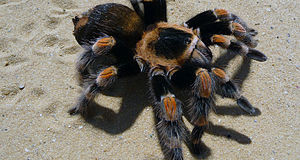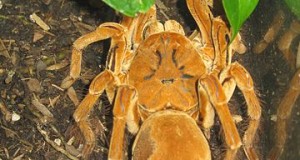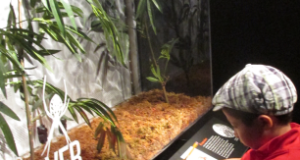In Part I of this article, we learned that less than 1% of the world’s 40,000+ spider species are dangerously venomous. Today I’d like to highlight their valuable role as insect predators and point out a few reasonable precautions that should be taken when keeping spiders in captivity.
Hunting Methods and Diet
Spiders consume animals ranging from mites to birds. Not all ensnare their prey in webs…some hunt by running (wolf spiders),  swimming (European diving bell spider), spitting silk (spitting spider), hiding in flowers (crab spider), throwing webs (bolas spider), luring fishes while floating (fishing spiders) or rushing from burrows fitted with hinged doors (trap door spider).
swimming (European diving bell spider), spitting silk (spitting spider), hiding in flowers (crab spider), throwing webs (bolas spider), luring fishes while floating (fishing spiders) or rushing from burrows fitted with hinged doors (trap door spider).
However, all spiders consume insects, including agricultural pests and disease-bearing species, to some degree. Field research has shown that harmful flies comprising over 60% of the diet of certain web-building species. It is estimated that the weight of the insects consumed yearly by spiders in New Zealand exceeds that of the island’s human population!
Precautions – Bites and Urticating Hairs
The fact that so few spiders are dangerous to people should not be taken as a license to ignore caution when dealing with them. Just as with bees and other venomous animals, allergic persons can be injured or killed by the bites of relatively benign species, and potentially fatal infections can be associated with the bite of any animal.
Also, many tarantulas shed urticating (irritating) hairs when disturbed or even when just moving about. A colleague of mine underwent major surgery to remove such hairs, deposited on his hand by a “tame” red-kneed tarantula, from his eye.
That being said, I have kept native and exotic spiders since childhood, and have never been bitten – because I do not pick up spiders with my hands. I urge you to handle spiders, if at all, with plastic tongs or by ushering them into a container.
Further Reading
The diving bell spider is certainly one of the world’s most interesting invertebrates – living within a submerged shelter that exchanges oxygen with the surrounding water and swimming after small fishes! To read more, click here.
Misumena vatia with wasp image referenced from wikipedia and originally posted by Olei.
 That Reptile Blog – Reptile, Amphibian and Exotic Pet Care and Information
That Reptile Blog – Reptile, Amphibian and Exotic Pet Care and Information




Hey very interesting blog!
Thanks you, much appreciated!, Frank